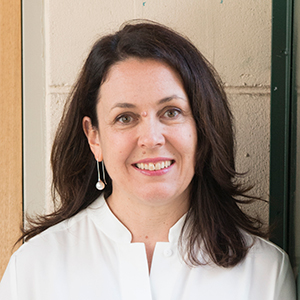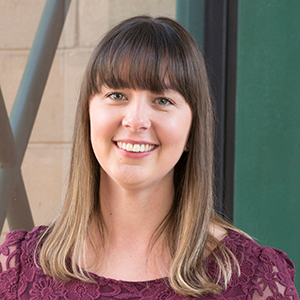Looming high on North Terrace, the University of South Australia’s new Health Innovation Building is a feat of architecture.
As impressive as the $247m health and research facility appears, what will happen within those walls is even more significant.
The Centre for Cancer Biology (CCB), a medical research institute and alliance between UniSA and SA Pathology, will relocate from its current home on Frome Road in Adelaide’s East End, to the upper floors of the Health Innovation Building in 2018.
 The Centre for Cancer Biology, which boasts the largest concentration of cancer research in South Australia, has seen many iterations over the years. Few people know this better than Associate Professor Natasha Harvey who is head of the CCB’s Lymphatic Development Laboratory.
The Centre for Cancer Biology, which boasts the largest concentration of cancer research in South Australia, has seen many iterations over the years. Few people know this better than Associate Professor Natasha Harvey who is head of the CCB’s Lymphatic Development Laboratory.
“I started my own lab here in 2005 in what was then the Hanson Institute,” she says. “So, I’ve been a member of the CCB since its inception, seen it grow, and now I’ll be part of the exciting move to the HIB.”
Walking through the CCB’s current home – a crammed rabbit warren of a building with labs and offices spread over three floors – it’s clear why the move will make a difference.
“This is an old building that has been progressively filled in over the years,” Assoc Prof Harvey says.
“So the prospect of moving into a state-of-the-art building that’s been designed specifically for us – from the electrical power points to imaging facilities and some space to grow and develop over time – is really exciting.
“I’m thrilled too because I’m currently in a small office with no windows.”
 Down the hallway, Research Associate Dr Sarah Boyle from the Tumour Microenvironment Laboratory, is in the process of ensuring equipment is tagged and the lab decluttered for the move to the Health Innovation Building.
Down the hallway, Research Associate Dr Sarah Boyle from the Tumour Microenvironment Laboratory, is in the process of ensuring equipment is tagged and the lab decluttered for the move to the Health Innovation Building.
“It’ll be a big move but just hearing about the sorts of facilities that are going to be over there – it’s going to be really good,” Dr Boyle says.
The Centre for Cancer Biology will have its own reception on the 11th floor. There are laboratories, offices and open spaces all co-located to encourage collaboration and new energy for researchers who have been operating, hidden away, in cramped conditions for years.
“Now everyone will actually know where we are,” Dr Boyle says. “We will have a face, and people will get to know us better and recognise the work that we’re doing.
“When you work in a pleasant space it really motivates you. We’ll be able to spread out a little more too, and really I’m so excited about just having windows.”
Awarded a fellowship last year from the Royal Adelaide Hospital Research Committee, Dr Boyle spends a typical day balancing a number of smaller in vitro (dish) and bigger in vivo (animal) experiments, and analysing results at the computer.
The rest of the day is filled with administrative tasks (including ethics paperwork and grant applications), looking after students, undertaking work for collaborating laboratories, attending seminars, and most importantly, spending time at the microscope looking for breakthroughs in her research.
“In our lab in particular, we are interested in the tumour microenvironment, investigating how cells that are not cancer cells, and proteins that are not cancer-derived, actually contribute to the growth of cancer,” Dr Boyle says.
The day before this interview, Dr Boyle had spent five hours with a microscope in a dark room.
"It’s exciting to think that no one has ever studied the specific interactions we are studying in this area. You can’t always guarantee it will be a major discovery, but there is something so interesting and intense about this work.”
The reason Dr Boyle was able to spend so much time with her latest project (to examine how the application of a certain drug affects the size of tumours), is because CCB now has a second confocal microscope (a specialist laser scanning microscope).
Before the recent addition, there was strong competition to access the technology.
“There was a time when I had to set my alarm for midnight to wake up and book this particular microscope, because you could only book it two weeks in advance,” Dr Boyle says.
“People don’t realise how much the lack of good facilities can impact on the research, slow it down, or simply make it much harder on researchers.”
The lack of facilities and space in CCB’s current location means the pending move to the West End will be a real boon for research practice.
One of the biggest drawcards of the new Health Innovation Building is that it is designed to enhance collaboration between different laboratories and research teams.
The new building offers excellent shared social spaces so that collaboration can continue beyond the labs.
Assoc Prof Harvey (whose lab is funded by grants from the Australian Research Council, and the National Health and Medical Research Council) and her team from the Lymphatic Development lab are working to understand the genetics and developmental biology underlying human lymphatic vessel disorders. This means they are working in close collaboration with the head of the Molecular Pathology Research Laboratory, Professor Hamish Scott, and his team of geneticists.
The genetics team recently made a significant discovery in the form of a gene that was mutated in a human lymph-edema syndrome. The gene is now an important focus for Assoc Prof Harvey and her research team.
“Every time there is a new result or a new piece of data – it makes all the difference. The potential for more cross-team collaboration is quite important,” she says.
“I really think every part of our work will be enhanced in the new building. The fact that we’ll be going from isolated little labs to big open working areas means that people will interact even more, so I see that as being beneficial for greater discussion outside people’s own expertise.”
The Centre for Cancer Biology’s 22 full-time research group leaders and their teams are constantly working towards breakthroughs in the causes of cancer.
Now their world-class innovative research and vital work will be reflected in their new surroundings.
The connectedness of the new collaborative working spaces and the state-of-the-art equipment are vital for the progress of this research, but it might just be the windows that make a difference for the researchers – windows to the world they hope to change.